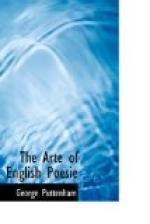CHAP. XI.
Of Proportion in figure.
Your last proportion is that of figure, so called for that it yelds an ocular representation, your meeters being by good symmetrie reduced into certaine Geometricall figures, whereby the maker is restrained to keepe him within his bounds, and sheweth not onley more art, but serueth also much better for briefenesse and subtiltie of deuice. And for the same respect are also fittest for the pretie amourets in Court to entertaine their seruants and the time withall, their delicate wits requiring some commendable exercise to keepe them from idlenesse. I find not of this proportion, vsed by any of the Greeke or Latine Poets, or in any vulgar writer, sauing of that one forme which they cal Anacreens egge. But being in Italie conuersant with a certaine gentleman, who had long trauailed the Orientall parts of the world, and seene the Courts of the great Princes of China and Tartarie. I being very inquisitiue to know of the subtillities of those countreyes, and especially in matter of learning and of their vulgar Poesie, he told me that they are in all their inuentions most wittie, and haue the vse of Poesie or riming, but do not delight so much as we do in long tedious descriptions, and therefore when they will vtter any pretie conceit, they reduce it into metricall feet, and put it in forme of a Lozange or square, or such other figure, and so engrauen in gold, siluer, or iuorie, and sometimes with letters of ametist, rubie, emeralde or topas curiousely cemented and peeced together, they sende them in chaines, bracelets, collars and girdles to their mistresses to weare for a remembrance. Some fewe measures composed in this sort this gentleman gaue me, which I translated word for word and as neere as I could followed both the phrase and the figure, which is somewhat hard to performe, because of the restraint of the figure from which ye may not digresse. At the beginning they wil seeme nothing pleasant to an English eare, but time and vsage will make them acceptable inough, as it doth in all other new guises, be it for wearing of apparell or otherwise. The formes of your Geometricall figures be hereunder represented.
[Illustration: labelled diagrams of lines of
different lengths (forming
different shapes):
The Lozange, called Rombus (diamond)
The Fuzie or spindle, called Romboides (narrow diamond)
The Triangle or Tricquet (pyramid)
The Square or quadrangle (square)
The Pillaster or Cillinder (tall rectangle)
The Spire or taper, called piramis (tall pyramid)
The Rondel or Sphere (circle)
The egge or figure ouall (vertical egg)
The Tricquet reuerst (triangle)
The Tricquet displayed (hour-glass)
The Taper reuersed (narrow triangle)
The Rondel displayed (half circle upon the other half)
The Lozange reuersed (wide diamond <>)
u
The Egge displayed (half oval upon the other half
— n)
The Lozange rabbated (hexagon).]




